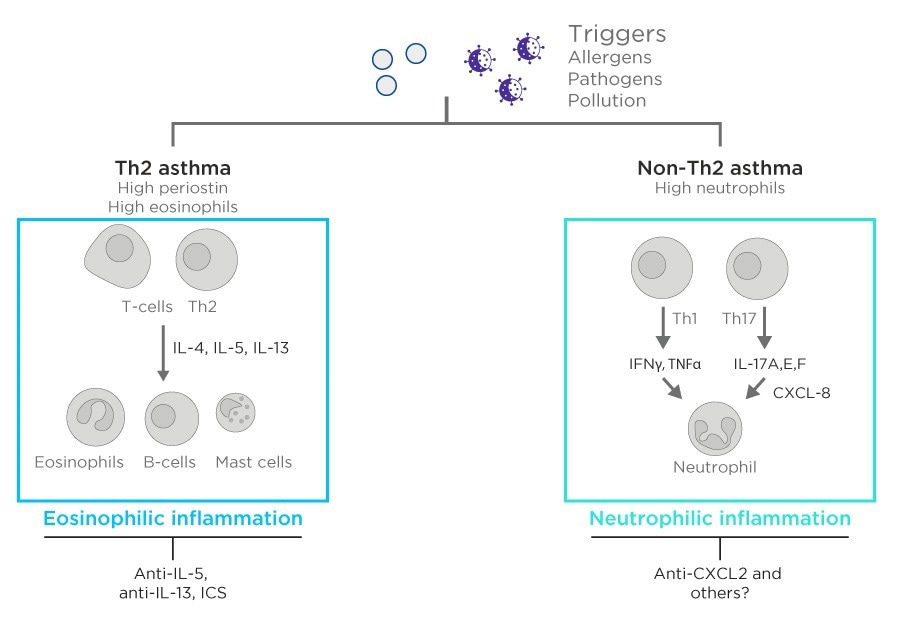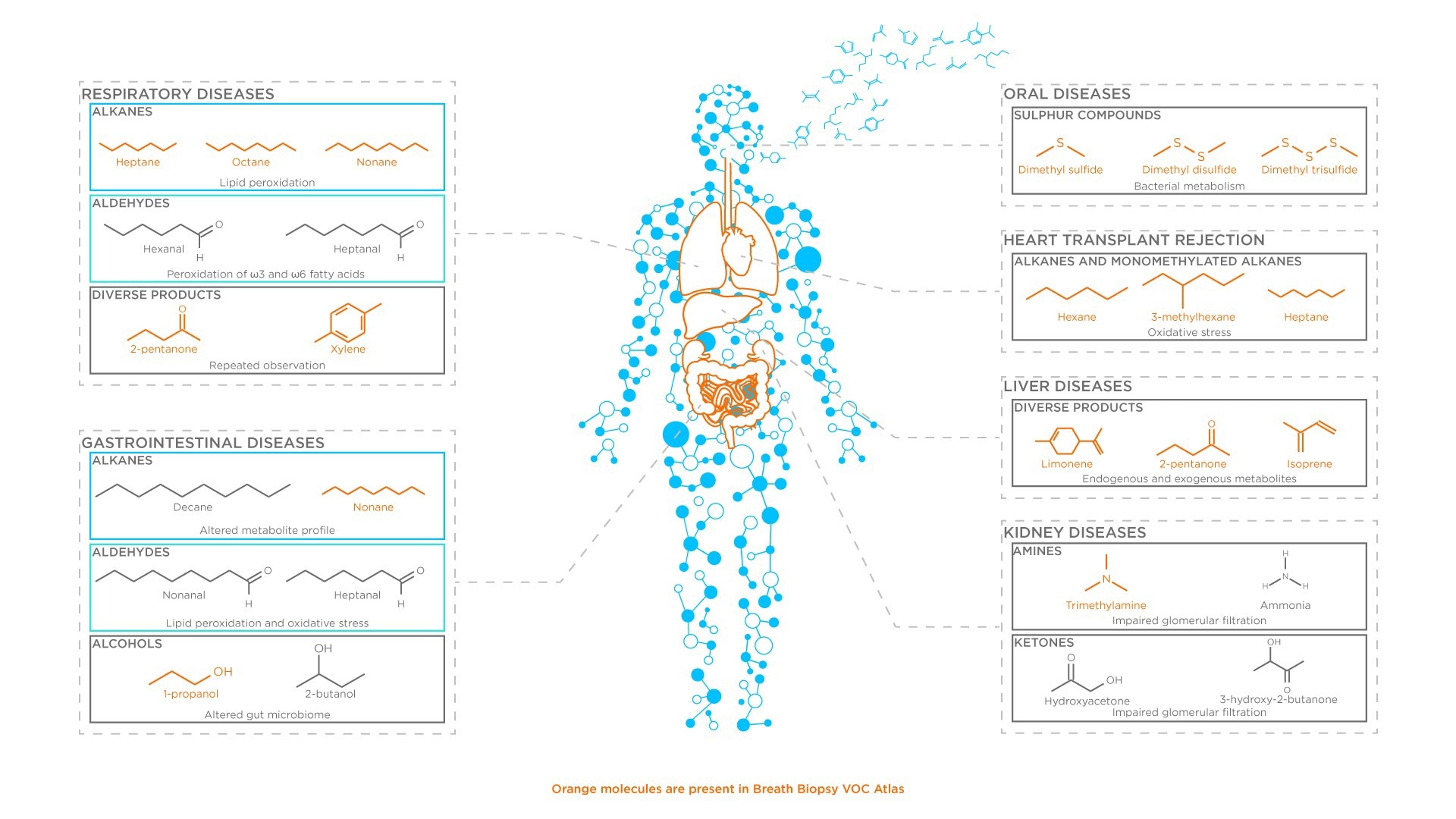Inflammation is a wide-ranging biological response that stimulates defense, healing, and repair as a response to injury or illness. It involves a complex network of responses that includes various biological pathways and cell types throughout the entire body, specifically within the immune system.
As such, it should be no surprise to state that several biomarker studies see inflammation as a potential biomarker source (e.g., see recent respiratory disease review by Ibrahim et al.1). But how useful and relevant can inflammation biomarkers be for disease diagnosis?
Numerous factors trigger inflammation, including injury, infection, and irritation. The main symptoms of an inflammatory response include heat, swelling, redness, and pain. Generally, inflammation is classified into two forms: acute and chronic.
Acute inflammation typically lasts a few hours or days and is primarily coordinated by neutrophils, while chronic inflammation can last for years and involves mononucleocytes. Long-term chronic inflammation becomes more common with age, and while it can be detrimental to general health, it may also be a factor in cancer progression.
We expect inflammation to produce breath biomarkers
For several inflammatory diseases, current diagnostic methods are expensive and also invasive. This can cause patients additional stress. Thus, a non-invasive alternative is highly appealing. Inflammation is a feature of many illnesses studied in breath research (Figure 1).
Inflammation is associated with chronic respiratory and liver diseases, cancers, infections, and gastrointestinal illnesses. Several inflammatory processes result in the production and discharge of small molecules, which, directly or indirectly, can become volatile organic compounds (VOCs) that can be detected in the breath.
Resultingly, breath biomarkers could offer a way to conduct cheaper, faster, non-invasive screening procedures to help diagnose and monitor inflammatory diseases.
A selection of diseases that involve inflammation and that have been explored through breath research.

Figure 1. A selection of diseases that involve inflammation and that have been explored through breath research. Image Credit: Owlstone Medical Ltd
Inflammation is associated with responses to hypoxia and processes such as oxidative stress/lipid peroxidation, pathogen metabolism, and breakdown. Some of these conditions have been explored previously in Owlstone’s series on lipid peroxidation and the Warburg effect. It should be noted that activated immune cells use systems affiliated with oxidative stress as a weapon to attack pathogens and destroy damaged cells.
Damaged and dying cells can be frequently found at sites of inflammation, and these, too, can release distinct macromolecules and metabolites, including the breakdown products of proteins and lipids. As such, inflammation may contain a wide range of potential biomarkers.

Figure 2. Unsaturated fatty acids can be converted into a complex range of pro- and anti-inflammatory compounds through various metabolic processes, illustrating the elaborate relationship between metabolism and regulation of inflammation. Image Credit: Adapted from Maskrey et al.2
Biomarkers of inflammation can be specific
Although inflammation is a common bodily reaction associated with many injuries and illnesses, there is justification to believe that biomarkers associated with inflammation are relevant for diagnosing and treating specific diseases.
There is a significant amount of redundancy in inflammation, with many triggers that can be detected and monitored by various parallel and complementary signaling systems (Figure 3), protein complexes, cell types, etc. All of these congregate toward achieving a similar outcome that establishes the main features of inflammation.
This implies several key differences between seemingly similar inflammation responses, and there is a significant reason to believe that the biomarkers of inflammation can vary from disease to disease and even between disease phenotypes.
This is a demonstratable fact in asthma, where various inflammatory endotypes, predicated on the presence of various immune cells, produce distinct disease phenotypes that demand divergent treatment regimes. Different asthma phenotypes are the result of parallel inflammation pathways. This graphic serves to illustrate just some of the complexity of inflammation and how this can result in different asthma types requiring different treatments e.g. inhaled corticosteroids (ICS).

Figure 3. Different asthma phenotypes are the result of parallel inflammation pathways. This graphic illustrates just some of the complexity of inflammation and how this can result in different asthma types requiring different treatments, e.g. inhaled corticosteroids (ICS). Image Credit: Adapted from Durham et al.3
Inflammation may also produce bodily byproducts that are extremely context-dependent (Figure 4). Processes such as lipid peroxidation discharge tiny molecules due to the interaction between reactive oxygen species and fatty acids in cell membranes.
The makeup of these membranes differs between cell types and between organelles, so it is reasonable to assume that there may be a correlation between the location where lipid peroxidation occurs and the combined mixture of small molecules produced.
Examples of how different inflammation processes and resulting small molecule biomarkers have been prospectively connected to different illnesses in a disease-specific manner.

Figure 4. Examples of how different inflammation processes and resulting small molecule biomarkers have been prospectively connected to different illnesses in a disease-specific manner. Image Credit: Owlstone Medical Ltd
It is not likely that biomarkers associated with inflammation would be used in isolation to make a final disease diagnosis. Even if inflammation always released the same composition of biomarkers, this would only offer a part of the wider diagnostic picture. Therefore, these biomarkers would likely be evaluated alongside others to provide a more specific result in the research.
The capacity to identify groups of biomarkers for disease detection is contingent on applying biomarker discovery tools like the reliable Breath Biopsy® OMNI, which has been optimized for broad-spectrum, high-sensitivity biomarker discovery.
Still more to discover
Inflammation offers a prospective source of rich and varied metabolic biomarkers that could affect the VOCs found in breath. Several studies have made associations between breath biomarkers and inflammation, and it is reasonable to assume that several others may exist.
More research is still required regarding the mechanistic connections between biomarkers and biology, but the prevalence of inflammation in injury and disease occurrences is clear, and clinical biomarkers will likely report on inflammatory processes in the future. Breath Biopsy is a non-invasive and reliable way to identify and study biomarkers in the breath.
References and further reading
- Ibrahim, W., et al., A systematic review of the diagnostic accuracy of volatile organic compounds in airway diseases and their relation to markers of type-2 inflammation. ERJ Open Research, 2021. 7(3): p. 00030-2021. DOI: 10.1183/23120541.00030-2021
- Maskrey, B.H., et al., Mechanisms of resolution of inflammation: a focus on cardiovascular disease. Arterioscler Thromb Vasc Biol, 2011. 31(5): p. 1001-6. DOI: 10.1161/ATVBAHA.110.213850
- Durham, A.L., et al., Targeted anti-inflammatory therapeutics in asthma and chronic obstructive lung disease. Translational Research, 2016. 167(1): p. 192-203. DOI: 10.1016/j.trsl.2015.08.004
- Ratiu, I.A., et al., Volatile Organic Compounds in Exhaled Breath as Fingerprints of Lung Cancer, Asthma and COPD. Journal of Clinical Medicine, 2021. 10(1): p. 32. DOI: 10.3390%2Fjcm10010032
- Kurada, S., et al., Review article: breath analysis in inflammatory bowel diseases. Alimentary Pharmacology & Therapeutics, 2015. 41(4): p. 329-41. DOI: 10.1111/apt.13050
- Ahmed, I., et al., Investigation of faecal volatile organic metabolites as novel diagnostic biomarkers in inflammatory bowel disease. Alimentary Pharmacology & Therapeutics, 2016. 43(5): p. 596-611. DOI: 10.1111/apt.13522
- Risby, T.H. and S.S. Sehnert, Clinical application of breath biomarkers of oxidative stress status. Free Radical Biology and Medicine, 1999. 27(11): p. 1182-1192. DOI: 10.1016/s0891-5849(99)00212-9
- Ligor, T., et al., Searching for Potential Markers of Glomerulopathy in Urine by HS-SPME-GC×GC TOFMS. Molecules, 2021. 26(7): p. 1817. DOI: 10.3390%2Fmolecules26071817
- Monedeiro, F., et al., VOC Profiles of Saliva in Assessment of Halitosis and Submandibular Abscesses Using HS-SPME-GC/MS Technique. Molecules, 2019. 24(16): p. 2977. DOI: 10.3390%2Fmolecules24162977
- Phillips, M., et al., Prediction of heart transplant rejection with a breath test for markers of oxidative stress. Am J Cardiol, 2004. 94(12): p. 1593-4. DOI: 10.1016/j.amjcard.2004.08.052
About Owlstone Medical Ltd
Owlstone Medical is developing a breathalyzer with a focus on non-invasive diagnostics for cancer, inflammatory disease and infectious disease, the company aims to save 100,000 lives and $1.5B in healthcare costs.
The company’s Breath Biopsy® platform has introduced a new diagnostic modality making it possible to discover novel non-invasive biomarkers in breath using a platform with the potential to transition to point-of-care. The award winning ReCIVA Breath Sampler ensures reliable collection of breath samples.
Breath Biopsy is supporting research into early detection and precision medicine with applications in cancer and a wide range of other medical conditions. Highly sensitive and selective, these tests allow for early diagnosis when treatments are more effective and more lives can be saved.
Sponsored Content Policy: News-Medical.net publishes articles and related content that may be derived from sources where we have existing commercial relationships, provided such content adds value to the core editorial ethos of News-Medical.Net which is to educate and inform site visitors interested in medical research, science, medical devices and treatments.